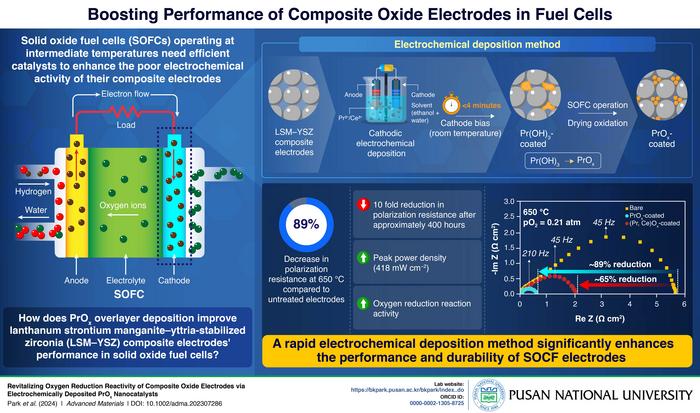Rising global demand for clean energy drives advancements in technologies like SOFCs, known for converting hydrogen and methane into emission-free electricity. SOFCs rely on key components: electrodes (cathode and anode) and the electrolyte, which are essential for converting chemical energy into electrical energy. These components are typically made from materials like lanthanum strontium manganite (LSM) and yttria-stabilized zirconia (YSZ). Combining LSM and YSZ to form LSM-YSZ enhances stability and durability, ensuring a prolonged electrode lifespan.

Credit: Professor Beom-Kyeong Park from Pusan National University, Korea
Rising global demand for clean energy drives advancements in technologies like SOFCs, known for converting hydrogen and methane into emission-free electricity. SOFCs rely on key components: electrodes (cathode and anode) and the electrolyte, which are essential for converting chemical energy into electrical energy. These components are typically made from materials like lanthanum strontium manganite (LSM) and yttria-stabilized zirconia (YSZ). Combining LSM and YSZ to form LSM-YSZ enhances stability and durability, ensuring a prolonged electrode lifespan.
Current SOFC technology faces challenges, notably electrode degradation, exacerbated at lower temperatures. Enhancing the oxygen reduction reaction (ORR) at the cathode is crucial for improving ion flow and overall fuel cell performance and durability. Addressing these issues is vital for expanding SOFC applications in energy conversion systems.
To address current challenges, a team of researchers led by Professor Beom-Kyeong Park recently conducted a study aimed at enhancing the performance of LSM–YSZ electrodes in SOFCs. Their research, available online since March 22, 2024, and published in Volume 36 of the Journal of Advanced Materials on June 20, 2024, focused on improving LSM–YSZ electrodes using nanocatalysts such as praseodymium oxide (PrOx). These catalysts, known for their high surface area-to-volume ratios, were employed to enhance the efficiency of the ORR.
Using cathodic electrochemical deposition (CELD), the research team efficiently deposited PrOx nanocatalysts onto LSM-YSZ electrodes in less than four minutes without requiring heat treatment. Prof. Park highlighted the significance, stating, “We harness the outstanding catalytic properties of PrOx to notably enhance the ORR activity of LSM–YSZ electrodes. The CELD method provides a rapid and cost-effective solution, feasible under standard operating conditions.”
The study demonstrated significant enhancements in SOFC electrode performance with PrOx coating, showing an 89% resistance reduction at high temperatures sustained over 400 hours. Achieving 418 mW cm−2 peak power density at 650°C surpassed other cathodes. Research also explored (Pr,Ce)Ox multicomponent coatings via electrochemical deposition, offering avenues for further optimization.
Prof. Park emphasizes the far-reaching implications of their research, stating, “By significantly enhancing electrode performance and durability, our method could pave the way for wider adoption of SOFCs in energy conversion and storage systems. This advancement holds immense promise for applications requiring reliable and sustainable power generation. It offers a pathway to mitigate greenhouse gas emissions and enhance global energy security.”
This innovative approach to creating high-performance energy devices, including all-ceramic materials, presents a promising future for clean energy technology.
***
Reference
Title of original paper: Revitalizing Oxygen Reduction Reactivity of Composite Oxide Electrodes via Electrochemically Deposited PrOx Nanocatalysts
Journal: Advanced materials
DOI: https://doi.org/10.1002/adma.202307286
About the institute
Pusan National University, located in Busan, South Korea, was founded in 1946 and is now the No. 1 national university of South Korea in research and educational competency. The multi-campus university also has other smaller campuses in Yangsan, Miryang, and Ami. The university prides itself on the principles of truth, freedom, and service, and has approximately 30,000 students, 1200 professors, and 750 faculty members. The university is composed of 14 colleges (schools) and one independent division, with 103 departments in all.
Website: https://www.pusan.ac.kr/eng/Main.do
About the author
Prof. Beom-Kyeong Park is an Assistant Professor in the School of Materials Science and Engineering at Pusan National University. His group focuses on developing innovative approaches to materials design, processing, and characterization to improve the efficiency and durability of solid oxide cells. In 2016, Prof. Park received a PhD in Materials Science and Engineering from KAIST, and subsequently completed the Postdoctoral training at Scott Barnett group, Northwestern University.
Lab Website: bkpark.pusan.ac.kr/bkpark/index..do
ORCID id: 0000-0002-1305-8725
Journal
Advanced Materials
DOI
10.1002/adma.202307286
Method of Research
Experimental study
Subject of Research
Not applicable
Article Title
Revitalizing Oxygen Reduction Reactivity of Composite Oxide Electrodes via Electrochemically Deposited PrOx Nanocatalysts
Article Publication Date
20-Jun-2024
COI Statement
The authors declare no conflict of interest.




